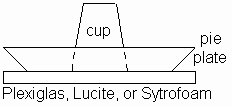|
About your report: Since you'll need to draw diagrams, make this a handwritten report to scan and submit to Brainhoney.
Preparation and Presentation
You must complete L153 before doing the following investigations. When explaining observations, you're now expected to use scientific terms introduced in the text. Include with your explanations sketches and sequences of sketches showing how you think the positive and negative charges are distributed over the objects as you perform the tests. Small sketches will be difficult for the instructor to interpret. Therefore, make each sketch at least a quarter page in size. For examples of how your sketches should look, see these figures in your textbook: 19.2, 19.4, 19.6 and 19.22.
Investigation V
-
Tear off about a square inch of aluminum foil and wad it around the end of your nylon thread so that the ball of foil won't slip off the thread. It's important to use nylon rather than cotton thread. Cotton thread can give poor results. Tape the loose end of the thread from the edge of your desk or from an overhead support so that the ball hangs freely in a pendulum arrangement. The ball must be far from the table legs or other objects that it might touch.
-
Neutralize the ball by touching it with your finger. This process is called grounding. If the ball has excess negative charge, that excess is conducted through you to ground. If the ball has excess positive charge, negative charge is conducted from the ground through you to neutralize the excess. In either case, negative charge is conducted. Why is negative rather than positive charge conducted? (By the way, this process of grounding is what you were doing in L153 when you passed the tape strips over your lips or a metal object. You were removing any excess charge on the strips. In this way, when you pulled the tape strips apart, they were given approximately equal and opposite charges.)
-
Charge a balloon by rubbing it with fur. Then bring the charged balloon close to but not touching the ball. (If the ball accidentally touches the balloon, neutralize the ball and try again.) Describe what you observe.
-
Explain your observation in step 3 in words and with a diagram. See Preparation and Presentation above for information about how your diagrams should look and what they should contain.
-
Ground the ball and bring the charged balloon near it again. This time, however, let the ball and balloon meet. Describe what you observe.
-
Explain your observation in step 5 in words and with a diagram.
-
Ground the ball. While holding the charged balloon near to but not touching the neutral ball, bring your finger close to the ball on the side opposite the balloon until your finger meets the ball. Be prepared to carefully observe everything that happens. Ground the ball and repeat the process as many times as necessary in order to be confident of your observations. Then describe what you observe.
-
Now explain your observations in step 7 in words and with a series of diagrams. Your diagrams must show how the charge is distributed on the balloon and the ball and how the distributions of charge change.
Investigation VI: The Electrophorus
-
 Tape the open end of a Styrofoam cup to the inside center of an aluminum pie plate
as shown in the diagram. In the following activities, use the Styrofoam cup as a handle.
Avoid touching the aluminum plate with your hands unless you have a reason
to do so. This simple device has the unusual name of electrophorus.
Tape the open end of a Styrofoam cup to the inside center of an aluminum pie plate
as shown in the diagram. In the following activities, use the Styrofoam cup as a handle.
Avoid touching the aluminum plate with your hands unless you have a reason
to do so. This simple device has the unusual name of electrophorus. -
Prepare top and bottom test strips as you did in L153.
-
Touch the pie plate to neutralize it initially. How can you test for neutrality using the test strips? Try it.
-
Use your flat piece of Styrofoam as a surface on which to place the pie plate. We'll call this the platform. Charge the platform by rubbing it vigorously with the rabbit fur. Bring the platform near the test strips. Is the platform positive or negative? How do you know?
-
Now place the platform on a table. Ground the pie plate once more to make sure it's neutral. Then, while holding the cup only, place the pie plate flat on the platform. Lift the pie plate immediately and test its charge with the test strips. Is the pie plate positive, neutral, or negative? How do you know?
-
Ground the pie plate and place it on the platform once again. Briefly touch the pie plate itself with a finger. Lift the pie plate from the platform and test its charge. Is the pie plate positive, neutral, or negative? How do you know?
-
Repeat your observations in steps 4-6 as needed in order to be confident of them.
-
Explain your observations in words and with a sequence of diagrams.